Effective Ways to Improve Loyalty Using Proactive Service

Proactive vs reactive customer service plays a crucial role in building lasting customer loyalty by anticipating needs before problems occur. For example, OPPO experienced a 57% increase in repurchase rates after implementing Sobot AI, which successfully resolved 83% of chatbot queries and significantly boosted customer satisfaction. According to recent research, 85% of customers prefer proactive communication, and 44% become repeat buyers following personalized service. Companies leveraging proactive strategies, such as those enabled by the Sobot call center automation, consistently outperform competitors who rely on reactive customer service methods.
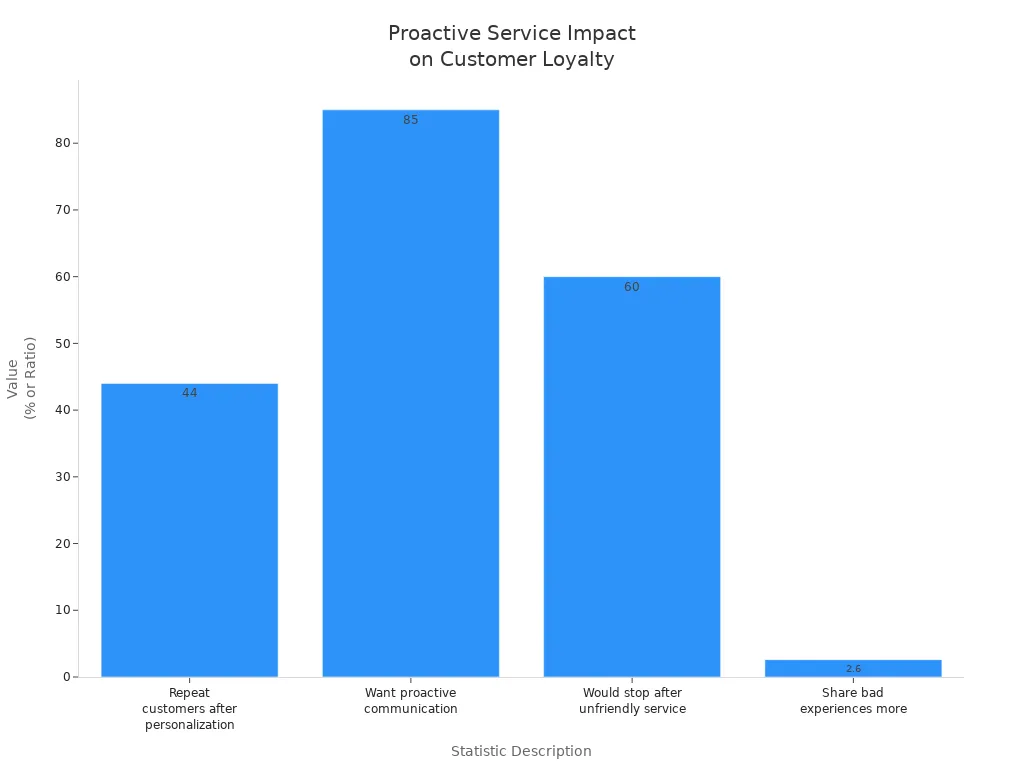
Proactive Customer Service Defined
Key Elements
Proactive customer service means anticipating customer needs and addressing issues before they become problems. Companies that use proactive service do not wait for customers to reach out with complaints. Instead, they take the initiative to solve potential concerns early. Industry experts highlight several core elements that define this approach:
- Anticipating customer needs and resolving issues before they arise.
- Building and training a skilled customer support team focused on proactive techniques.
- Leveraging technology, such as AI chatbots and self-service tools, to provide instant help.
- Communicating proactively across channels like email, social media, and SMS to keep customers informed.
- Personalizing engagement based on customer history and preferences.
- Using feedback loops, surveys, and analytics to improve service strategies.
- Sending predictive alerts to prevent product or service issues.
- Reducing customer effort by resolving concerns quickly, often in a single interaction.
Sobot’s AI-powered chatbot and omnichannel solutions help businesses deliver proactive customer service by automating responses and providing 24/7 support. These tools allow companies to reach out to customers with helpful information, updates, or solutions before customers even ask. This approach not only saves time but also builds trust.
Note: According to research, 86% of customers are willing to pay more for a better customer experience, and 93% are more likely to make repeat purchases from companies that offer excellent customer service (source).
Impact on Customer Loyalty
Proactive customer service has a direct impact on customer loyalty. When companies focus on anticipating customer needs, they show customers that their satisfaction matters. This leads to stronger relationships and higher retention rates. For example, loyalty programs often use customer data to offer personalized support and faster resolutions, which makes customers feel valued.
Proactive outreach, such as sending targeted offers or helpful messages to at-risk customers, helps prevent churn. High-quality interactions during loyalty program inquiries also increase retention. Satisfied customers become brand advocates, sharing positive experiences with friends and on social media. This word-of-mouth promotion further boosts customer loyalty.
Sobot’s solutions empower businesses to deliver proactive service by integrating customer data, automating outreach, and providing seamless support across channels. Companies that adopt these strategies see measurable improvements in customer loyalty, satisfaction, and long-term value.
Proactive vs Reactive Customer Service
Main Differences
Understanding the main differences between proactive vs reactive customer service helps organizations choose the right strategy for building loyalty. Proactive customer service anticipates customer needs and solves issues before they become problems. Reactive customer service responds only after a customer reaches out with a question or complaint. The following table highlights these distinctions:
| Aspect | Proactive Customer Service | Reactive Customer Service |
|---|---|---|
| Definition | Anticipates and resolves issues before they occur using data and predictive strategies. | Responds to inquiries and problems after they arise. |
| Examples | Personalized recommendations, proactive notifications, service reminders. | Handling complaints, troubleshooting, responding to queries. |
| Benefits | Enhanced satisfaction, loyalty, reduced churn, positive brand perception, cost efficiency. | Handles unforeseen issues, provides learning from feedback, flexible resource allocation. |
| Drawbacks if used alone | Requires upfront investment and strong data capabilities. | Can cause delays, frustration, inefficiencies, and poor experience if used alone. |
| Strategic Recommendation | Best results come from balancing both approaches. | Acts as a safety net for missed proactive efforts. |
Most companies start with reactive customer service, helping customers after a problem appears. However, customer experience research shows that 71% of customers prefer proactive support. Proactive vs reactive customer service is not just about timing; it is about mindset and strategy.
Benefits of Proactive Approaches
Proactive vs reactive customer service models deliver different results. Companies that use proactive customer service see higher satisfaction and retention rates. Proactive service uses predictive analytics to identify at-risk customers and reach out before issues escalate. This approach prevents problems, builds trust, and reduces the need for costly incentives to retain customers.
Organizations adopting proactive customer service report measurable benefits:
- Improved customer satisfaction scores, often aiming for 95% or higher.
- Increased first-contact resolution rates, sometimes by 15%.
- Reduced response times, with some companies lowering average response to under one hour.
- Lower operational costs through automation and self-service tools like Sobot’s AI Chatbot.
- Higher employee engagement and better alignment with business goals.
For example, Sobot’s omnichannel solutions help businesses automate outreach and provide 24/7 support, making proactive service possible across all channels. Companies like OPPO have seen a 57% increase in repurchase rates after shifting to proactive vs reactive customer service models. These results show that proactive customer service not only improves customer experience but also drives business growth and loyalty.
Improve Customer Loyalty with Sobot
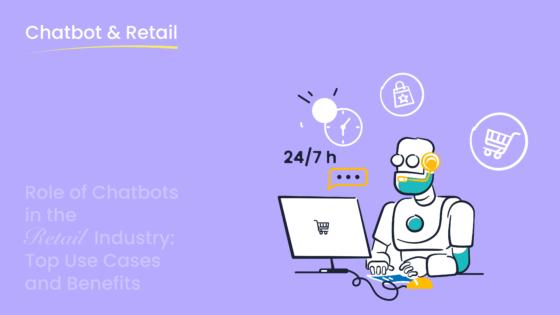
Leveraging Chatbot Automation

Sobot’s AI-powered chatbot stands at the forefront of modern customer support, helping businesses improve customer loyalty by delivering fast, empathetic, and personalized service. The chatbot uses advanced AI to recognize customer emotions and respond with empathy, which builds trust and increases customer satisfaction. By analyzing customer data and behavior, Sobot’s chatbot tailors each interaction, making every customer feel understood and valued.
Key features of Sobot’s chatbot automation that drive customer loyalty include:
- AI-powered empathy and emotional intelligence, which help build trust and satisfaction.
- Personalized interactions based on customer data, increasing engagement and retention.
- Seamless escalation of complex issues to human agents, ensuring customers always receive the right support.
- Instant, consistent 24/7 support, making customers feel valued at any time.
- Quick problem resolution, which saves time for both customers and agents.
- Personalized recommendations and tailored responses, enhancing engagement and loyalty.
According to MIT Media Lab, AI systems with emotional recognition can improve customer satisfaction by up to 30%. Companies like Domino’s Pizza and Uber have adopted similar AI-powered chatbots to deliver personalized and empathetic service, showing the growing importance of this technology in customer support.
Sobot’s chatbot automation not only answers questions but also anticipates needs. For example, it can send proactive notifications about order status, product updates, or service reminders. This proactive approach helps businesses improve customer loyalty by reducing customer effort and preventing issues before they arise.
OPPO, a global leader in smart devices, provides a real-world example of how Sobot’s chatbot automation transforms customer support. During peak shopping periods, OPPO faced a surge in customer inquiries. By implementing Sobot’s chatbot and ticketing system, OPPO achieved an 83% chatbot resolution rate. This meant that most customer questions were resolved instantly, without waiting for a human agent. As a result, OPPO saw a 94% positive feedback rate and a 57% increase in repurchase rates. These outcomes highlight how Sobot’s automation can improve customer loyalty and drive measurable business growth.
Omnichannel Experience
Sobot’s omnichannel solution takes customer support to the next level by integrating all customer touchpoints—websites, apps, social media, and internal CRM systems—into a single, unified platform. This seamless integration reduces data fragmentation and ensures that every customer receives consistent, personalized service, no matter which channel they use.
The impact of Sobot’s omnichannel experience on customer loyalty is clear when looking at industry benchmarks and real-world results:
| Metric | Result / Benchmark | Description |
|---|---|---|
| Chatbot Resolution Rate (OPPO) | 83% | Percentage of customer inquiries resolved by Sobot’s AI chatbot, indicating efficient automated support. |
| Repurchase Rate Increase (OPPO) | 57% | Growth in customer repurchase rate after adopting Sobot’s platform, showing enhanced loyalty. |
| Average Customer Retention (Omnichannel AI users) | 89% | Industry benchmark retention rate for companies using omnichannel AI marketing strategies, significantly higher than weaker strategies. |
| Purchase Rate Increase (Omnichannel AI users) | 287% | Increase in purchase rates compared to single-channel campaigns, demonstrating effectiveness of omnichannel engagement. |
| AI Handling of Customer Interactions (Forecast for 2025) | 95% | Expected percentage of customer interactions managed by AI, underscoring the importance of AI-driven omnichannel solutions. |
Sobot’s omnichannel platform leverages conversational AI, predictive analytics, and real-time personalization engines. These technologies allow businesses to maintain context across every interaction, anticipate customer needs, and orchestrate tailored customer journeys. By integrating multiple channels, Sobot enables customer support teams to access complete customer histories and provide faster, more accurate responses.
Note: Sobot’s omnichannel solution supports data-driven engagement and automated customer support, which are key drivers of improved customer satisfaction, retention, and loyalty.
A closer look at OPPO’s experience demonstrates the power of Sobot’s omnichannel approach. After integrating Sobot’s AI-driven chatbot and marketing solutions, OPPO achieved an 83% chatbot resolution rate and a 57% increase in repurchase rate. These results show how seamless, personalized support across multiple channels can transform customer service efficiency and loyalty program outcomes.
Sobot’s omnichannel solution also helps businesses improve customer loyalty by:
- Providing a unified workspace for agents, which streamlines workflows and reduces response times.
- Offering consistent, personalized experiences across all channels, which builds trust and encourages repeat business.
- Enabling proactive outreach, such as sending targeted offers or helpful messages to at-risk customers, which helps prevent churn.
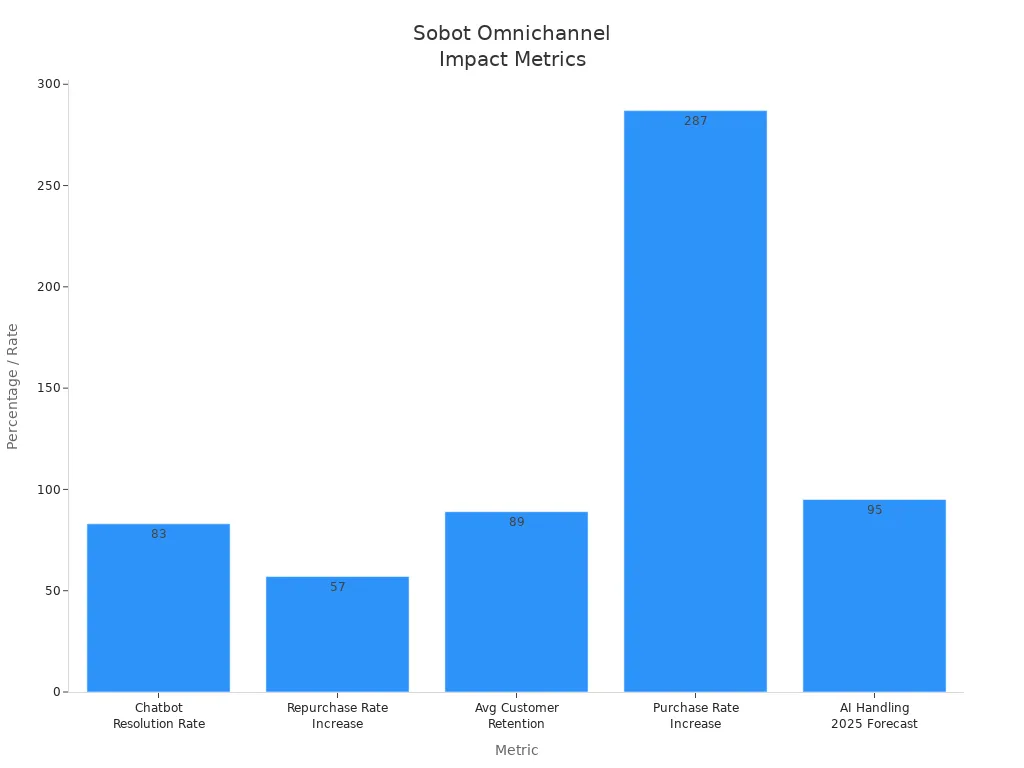
Industry data supports these outcomes. Companies using omnichannel AI marketing strategies see an average customer retention rate of 89% and a 287% increase in purchase rates compared to single-channel campaigns. By 2025, experts predict that AI will handle 95% of customer interactions, making solutions like Sobot essential for businesses that want to improve customer loyalty and stay ahead in a competitive market (source).
Sobot’s commitment to innovation, customer-centricity, and efficiency ensures that businesses can deliver proactive, seamless, and personalized customer support. This approach not only improves customer loyalty but also drives long-term business success.
Proactive Communication Strategies
Personalized Outreach
Personalized outreach forms the backbone of proactive customer service. Companies use customer data and AI to tailor messages, offers, and support to each individual. This approach helps businesses build stronger relationships by showing customers they are valued and understood. Sobot’s omnichannel platform enables brands to deliver personalized messages across chat, email, and social media, ensuring every interaction feels unique.
Recent studies highlight the impact of personalized outreach on customer loyalty:
| Evidence Type | Description | Supporting Data / Example |
|---|---|---|
| Quantitative Study Results | Personalized proactive communication increases customer satisfaction, retention, and reduces churn | McKinsey: 20-30% increase in satisfaction; 10-15% reduction in complaints |
| AI-Powered Tools | Use of predictive analytics, personalized messaging, real-time engagement to tailor interactions | Amazon & Netflix use machine learning for personalized recommendations, boosting engagement and loyalty |
| Hyper-Personalization Stats | Customer expectations and behavior related to personalization | Zendesk: 75% expect personalized interactions; 73% more likely to return |
| Predictive Analytics Impact | Anticipating customer needs to improve loyalty and reduce churn | Gartner: 10-15% increase in satisfaction; 10-20% reduction in churn |
| Emotional Recognition | Adjusting communication based on customer emotions | MIT Media Lab: 20-30% increase in satisfaction; 15-25% reduction in churn |
| Leading Loyalty Indicators | Metrics to track success of personalized outreach | Zendesk: 25% increase in engagement rates; MIT Sloan: 15% increase in satisfaction via sentiment analysis |
| Customer Effort Reduction | Lowering customer effort through proactive communication enhances loyalty | Gartner: 85% more likely to do business with proactive service providers |
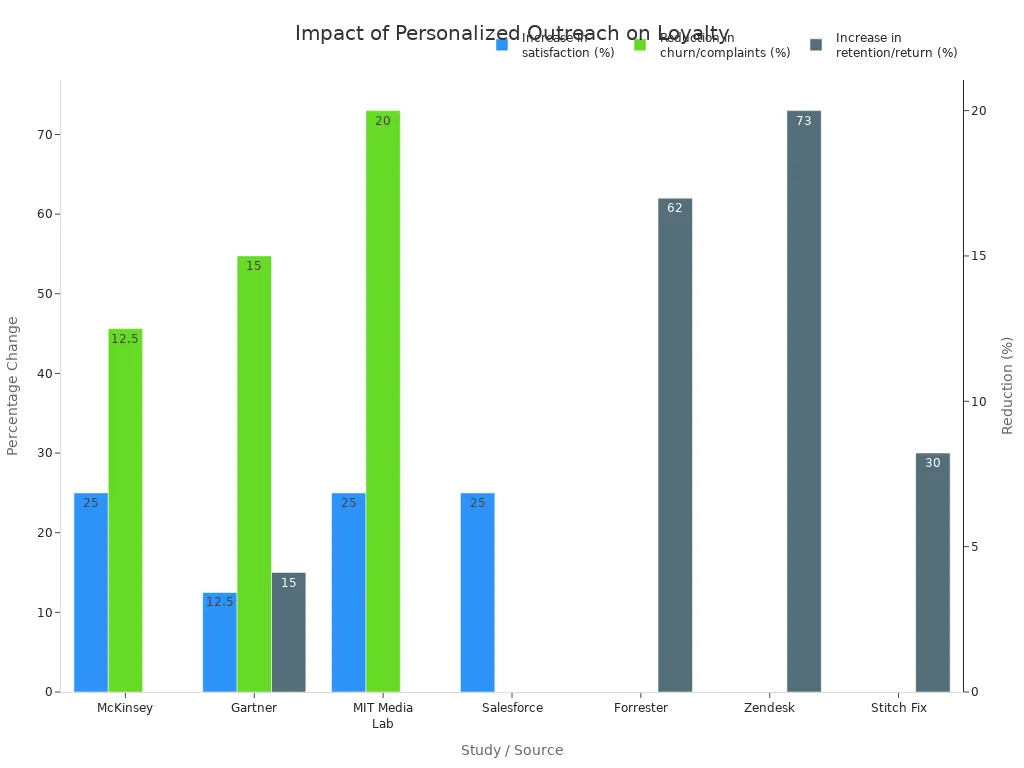
Sobot’s AI chatbot uses predictive analytics to identify customer preferences and send relevant messages. This not only increases satisfaction but also reduces churn, helping brands maintain stronger relationships over time.
Automated Notifications
Automated notifications play a vital role in proactive customer service. These notifications keep customers informed about order status, renewals, payment reminders, and feedback requests. Sobot’s automation tools allow businesses to send timely, personalized alerts across multiple channels, reducing manual workload and ensuring consistent engagement.
- Automated notifications include renewal reminders, payment alerts, and feedback surveys.
- Businesses use automation to send welcome emails, post-purchase messages, and re-engagement campaigns.
- Subscription services benefit from advance notices and failed payment recovery, which help reduce churn.
- AI-driven tools analyze customer behavior and trigger alerts for low engagement or milestones.
- Companies using AI retention software report a 30% increase in customer retention rates (Loyally.ai).
- Platforms like Sobot integrate feedback collection and support automation, providing real-time insights and responses.
Automated alerting systems help businesses identify customers at risk of leaving. By monitoring key signals and sending timely notifications, companies can intervene early and strengthen customer loyalty. Sobot’s proactive customer service tools empower brands to anticipate customer needs and build stronger relationships through every stage of the customer journey.
Empowering Self-Service
Knowledge Base
A well-organized knowledge base empowers customers to solve problems on their own. Companies that offer digital FAQs, how-to guides, and searchable help centers see a clear boost in customer satisfaction. Research shows that 88% of consumers expect online self-service support, and 61% prefer to resolve simple issues without contacting an agent. A strong knowledge base provides instant access to accurate information, which reduces wait times and support tickets. This approach allows support teams to focus on complex cases, improving productivity and reducing costs.
Companies using knowledge bases report up to a 5% reduction in support calls and a 30% drop in call volume, according to industry data. First Contact Resolution can improve by 25%, and Average Handle Time can decrease by up to 25%. These improvements lead to higher customer satisfaction and lower operational expenses (source).
Sobot’s knowledge base integrates with its omnichannel platform, making it easy for customers to find answers anytime. The system delivers consistent, up-to-date information, which builds trust and confidence. By reducing customer effort, businesses can increase loyalty and streamline operations.
AI Chatbot Support
AI chatbots have become essential for reducing customer effort and delivering 24/7 support. Studies reveal that 80% of customers expect round-the-clock help, but less than half of companies meet this need. Sobot’s AI chatbot responds instantly, with wait times under five seconds. It supports multiple languages, allowing customers worldwide to get help in their native language.
Sobot’s chatbot stands out by offering personalized, proactive engagement. It records customer details, avoids repetitive questions, and provides seamless handoffs to human agents when needed. Companies using Sobot’s chatbot have seen a 25% increase in conversion rates and a 30% reduction in support costs. These features help businesses reach more customers, reduce costs, and improve satisfaction.
Self-service tools like Sobot’s chatbot and knowledge base play a key role in reducing customer effort. They enable customers to resolve issues independently, which leads to higher satisfaction and loyalty.
Using Data to Enhance Customer Experience
Customer Feedback Loops
Customer feedback loops play a vital role in enhancing customer satisfaction and loyalty. Companies collect feedback through surveys, app reviews, and direct messages. They analyze this input to identify pain points and areas for improvement. By acting on feedback, businesses show customers that their opinions matter, which builds trust and encourages repeat business.
| Aspect of Feedback Loop | Explanation | Example | Impact on Customer Service and Loyalty |
|---|---|---|---|
| Aligning Product with Customer Needs | Feedback reveals why features may be underused or confusing. | SaaS tool introduces a new feature that is barely used; feedback shows confusion or lack of value. | Ensures product relevance, increasing satisfaction. |
| Minimizing Churn and Building Loyalty | Immediate fixes based on complaints reduce frustration. | Fixing clunky integrations after repeated complaints and informing customers. | Builds trust, reduces churn, increases engagement. |
| Driving Data-Driven Decisions | Feedback removes guesswork, backing decisions with real data. | Using customer feedback to prioritize product development. | Leads to better product-market fit and higher ROI. |
| Ensuring Continuous Improvement | Ongoing collection and action on feedback fosters innovation. | Iteratively refining user interface based on feedback. | Keeps customers engaged and product competitive. |
Sobot’s omnichannel platform makes it easy to gather and analyze feedback from every channel. Businesses can acknowledge feedback in real time, show how they act on suggestions, and refine their processes. This approach ensures continuous improvement and helps in enhancing customer satisfaction at every touchpoint.
Tip: Closing the loop by communicating changes back to customers reinforces trust and strengthens long-term relationships.
Personalization with Analytics
Personalization powered by analytics transforms the customer experience. Companies use data to understand preferences, predict needs, and deliver relevant offers. This strategy leads to higher engagement and loyalty.
- Companies that excel at personalization generate 40% more revenue, according to McKinsey.
- Nearly 80% of consumers are more likely to repurchase from brands that personalize their experience.
- AI and machine learning enable real-time, individualized interactions, which foster repeat engagement.
- British supermarket Waitrose saw a 66.8% increase in engagement after using AI-driven personalized recommendations (source).
- Skechers EU achieved a 30% lift in conversion rate after implementing personalized experiences.
Banks like Wells Fargo and Citibank use customer data analytics to tailor products, map journeys, and identify at-risk customers. The table below shows how data-driven strategies impact customer satisfaction and retention:
| Aspect | Institution | Description | Impact |
|---|---|---|---|
| Hyper-Personalization | Wells Fargo | Uses customer data analytics to tailor products and services to individual customer needs. | 40% increase in cross-selling rates; 20% improvement in customer satisfaction. |
| Predictive Analytics for Retention | Wells Fargo | Identifies at-risk customers to enable proactive engagement and reduce churn. | 30% improvement in retention rates; 20% reduction in churn. |
| Customer Journey Mapping | Citibank | Maps customer touchpoints to identify pain points and optimize experience. | 25% increase in customer satisfaction; 15% reduction in service complaints. |
| Real-Time Customer Feedback | HSBC | Integrates feedback tools in mobile app for immediate customer input and quick issue resolution. | 15% decrease in service complaints; 20% increase in customer satisfaction. |
Sobot’s AI-powered solutions help businesses harness analytics for hyper-personalization. The platform tracks customer behavior, segments audiences, and delivers targeted messages. This not only enhances customer satisfaction but also increases conversion rates and loyalty. By using real-time data, companies can anticipate needs and provide proactive support, making every interaction more meaningful.
Building a Proactive Service Culture
Team Training
A proactive service culture starts with strong team training. Leaders set clear objectives and model customer-centric behaviors. They encourage employees to engage with customers and anticipate needs. Regular training sessions help support teams master proactive customer service techniques. These sessions cover skills such as active listening, empathy, and multi-channel support. Employees learn to use tools like live chat and AI chatbots, which help them respond quickly and accurately.
- Training support staff in proactive customer service across channels prepares them to address customer needs before issues arise.
- Empowered teams use customer feedback to improve service and personalize support.
- Coaching and ongoing education help employees resolve problems swiftly, which builds trust and satisfaction.
Companies that invest in team training see measurable results. Customer Satisfaction Score (CSAT) and Net Promoter Score (NPS) often rise after teams receive training in proactive customer service. Employees who feel confident and supported deliver better experiences, which leads to building customer loyalty. Sobot provides resources and training for its omnichannel platform, ensuring teams can use automation and analytics to enhance every customer interaction.
Tip: Empowering employees with the right tools and knowledge enables them to turn feedback into action, creating memorable experiences that drive loyalty.
Continuous Improvement
Continuous improvement keeps proactive customer service effective over time. Organizations that succeed in building customer loyalty focus on small, ongoing changes. They empower employees to make decisions and solve problems quickly. Regular feedback sessions and open communication channels help teams share insights and brainstorm solutions.
- Empower employees with decision-making authority and ongoing training.
- Maintain transparent communication with customers, including regular updates and feedback requests.
- Use proactive problem-solving to address issues before they escalate.
- Conduct regular audits and customer satisfaction surveys to ensure high standards.
- Streamline processes with automation tools like Sobot’s AI chatbot to improve efficiency.
Companies like Toyota and Apple have shown that continuous, incremental improvements lead to high customer loyalty and profitability. Sobot’s platform supports this approach by providing analytics, feedback tools, and automation. These features help businesses adapt quickly to customer needs and maintain excellent service.
A proactive service culture relies on leadership commitment, employee engagement, and a focus on continuous learning. When every team member understands the value of proactive customer service, organizations see higher satisfaction, stronger trust, and lasting loyalty.
Companies that invest in proactive strategies see measurable gains in customer loyalty and customer experience. Market studies show that personalized support, predictive analytics, and seamless omnichannel service drive retention and revenue growth. Sobot’s AI-powered solutions help businesses reduce churn, boost satisfaction, and improve productivity.
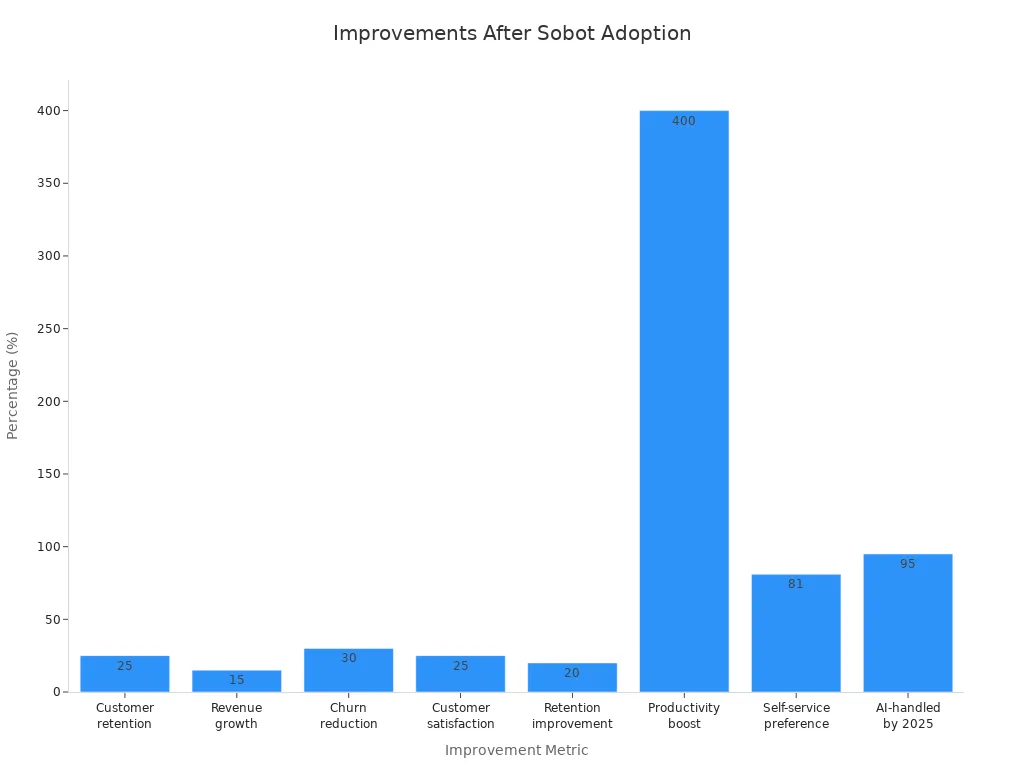
Leaders should review their current approach and consider adopting at least one proactive strategy. Leveraging technology like Sobot can transform service and build lasting loyalty. Start today to create a better customer experience and stronger customer loyalty.
FAQ
What is proactive customer service, and why does it matter for customer loyalty?
Proactive customer service means helping customers before they ask for help. Companies using this approach see up to 57% higher repurchase rates. Sobot’s AI chatbot and omnichannel solution make proactive support easy, which builds strong customer loyalty.
How does Sobot’s AI chatbot improve customer loyalty?
Sobot’s AI chatbot answers questions instantly, 24/7, in multiple languages. It solves up to 83% of queries without human help. This fast, reliable support increases customer loyalty and satisfaction. Learn more about Sobot’s chatbot here.
What are the benefits of an omnichannel solution for proactive customer service?
An omnichannel solution connects all customer channels, like chat, email, and social media, in one place. Sobot’s omnichannel platform helps agents respond faster and keeps service consistent. Companies using omnichannel support see up to 89% customer retention (source).
Can proactive customer service reduce support costs?
Yes! Proactive customer service, powered by Sobot’s automation tools, can cut support costs by up to 50%. The AI chatbot handles routine questions, so agents focus on complex issues. This saves time and money while improving customer loyalty.
How can companies start using proactive customer service strategies?
Companies can start by using Sobot’s AI chatbot and omnichannel solution. These tools automate outreach, send helpful notifications, and collect feedback. Proactive customer service builds trust, increases customer loyalty, and helps businesses grow.
See Also
Top Ten Ways To Improve Live Chat Satisfaction
Ten Key Tips For Selecting Social Media Support Tools
How To Successfully Manage Live Chat Support Agents
